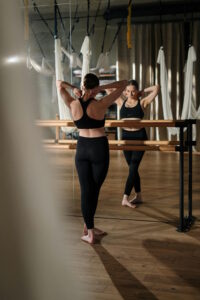
Pilates, a fitness method that emphasizes strength, flexibility, and control, has garnered a legion of success stories from individuals around the world. These stories are a testament to the remarkable impact Pilates can have on one’s physical and mental well-being. In this exploration of Pilates success stories, we’ll delve into the experiences of those who have embarked on their Pilates journeys and achieved incredible transformations.
How long does it take to see results after Pilates?
The timeline for experiencing results from Pilates can vary significantly from person to person, depending on several factors:
· Consistency: The more consistently you practice Pilates, the quicker you are likely to see results. Regular practice, ideally multiple times a week, accelerates progress.
· Starting Point: Your initial fitness level and familiarity with Pilates play a role. Beginners may notice changes sooner, while those with more experience may have different expectations.
· Goals: The specific goals you’ve set will influence when you start seeing results. For instance, improvements in flexibility and posture may be noticeable sooner than changes in muscle definition or weight loss.
· Body Type: Individual differences in body composition and genetics can affect how quickly results become apparent.
In general, many people report feeling more energized and experiencing improved posture and flexibility within a few weeks of consistent Pilates practice. Noticeable changes in muscle tone and strength may take a few months, while significant transformations, such as weight loss, can take several months to a year or more.
Can Pilates really change your body?
Yes, Pilates can significantly change your body when practiced consistently and with a well-rounded approach. Here are some of the ways Pilates can impact your body:
· Improved Muscle Tone: Pilates engages and strengthens various muscle groups, leading to enhanced muscle definition and tone.
· Enhanced Flexibility: Regular Pilates practice increases flexibility by targeting specific muscle groups and promoting a full range of motion.
· Better Posture: Pilates emphasizes proper alignment and body awareness, which can lead to improved posture and reduced musculoskeletal discomfort.
· Core Strength: Pilates is renowned for its core-strengthening benefits, which can result in a stronger and more stable core.
· Increased Body Awareness: Pilates encourages mindfulness of movement and body positioning, helping you become more in tune with your body’s needs.
· Balanced Muscle Development: Pilates exercises promote balanced muscle development, reducing the risk of muscle imbalances and related injuries.
· Stress Reduction: The focus on controlled movements and breathing in Pilates can alleviate stress and promote relaxation.
· Injury Prevention and Rehabilitation: Many individuals turn to Pilates for injury prevention and rehabilitation, as it can help address physical imbalances and promote healing.
What happens to your body after a year of Pilates?
After a year of consistent Pilates practice, many individuals report significant transformations in their bodies and overall well-being:
· Improved Muscle Tone and Definition: Muscle tone becomes more pronounced, leading to a leaner and more sculpted appearance.
· Enhanced Flexibility: A year of Pilates can result in remarkable improvements in flexibility, making everyday movements easier and reducing the risk of injuries.
· Better Posture: Good posture becomes second nature, reducing discomfort and supporting spinal health.
· Core Strength: Core strength reaches new levels, contributing to better stability and balance in daily activities.
· Reduced Stress: The mindfulness and relaxation aspects of Pilates often lead to reduced stress levels and improved mental clarity.
· Increased Confidence: Many individuals gain confidence in their physical abilities and appearance after a year of Pilates practice.
How many times a month should I do Pilates to see results?
The frequency of Pilates sessions required to see results depends on your goals and current fitness level. However, a general guideline is to aim for at least 2-3 Pilates sessions per week for noticeable results. This level of consistency allows your body to adapt to the exercises and experience improvements in strength, flexibility, and other areas. As you progress, you can adjust your frequency and intensity to align with your goals.
In conclusion, Pilates success stories serve as inspiring examples of the transformative power of this versatile fitness method. While the time it takes to see results can vary, consistency, clear goals, and a holistic approach to Pilates practice can lead to remarkable changes in one’s body and overall well-being. Whether you’re a beginner or an experienced practitioner, Pilates has the potential to unlock your body’s full potential and empower you on your fitness journey.